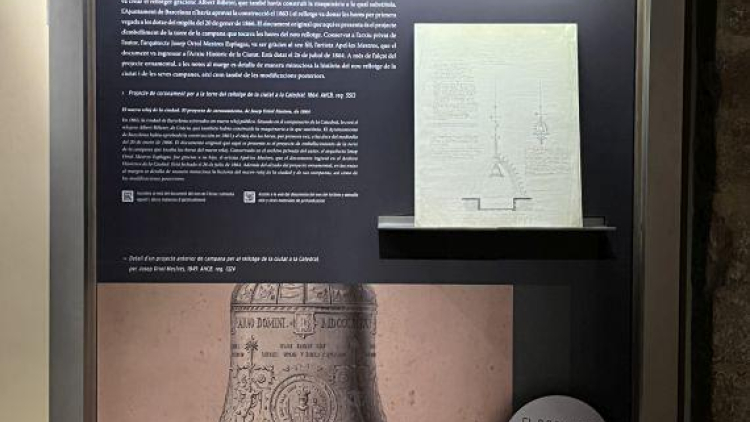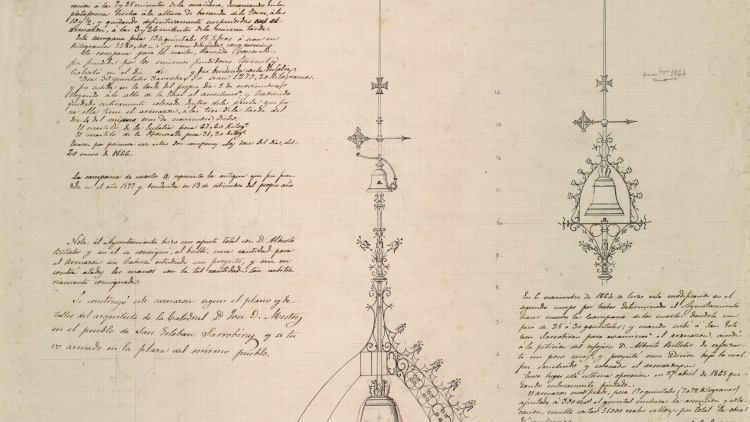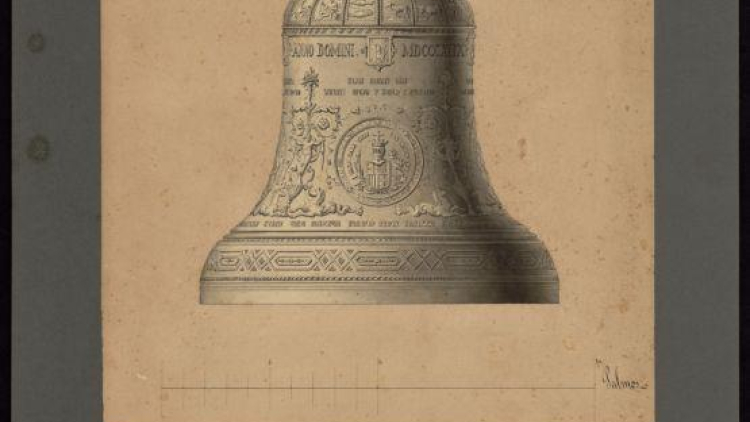The city’s new clock
Publication date of the document: 03/01/2022
Year of the original document: 1865
Barcelona officially opened a new public clock in 1865. Located in the Cathedral’s belfry, like the machinery it replaced – currently conserved in the Museu d’Història de Barcelona – it was created by the Gràcia-based clockmaker, Albert Billeter. Having received Barcelona City Council's approval for its construction in 1863, it began to show the time, for the first time, at 12.30 noon on 20 January 1866. The original document presented here is the plan for embellishing the belfry whose bell used to toll the new clock’s time, kept in its private archive by its author, the architect Josep Oriol Mestres Esplugas, who was the father of the artist Apel·les Mestres, through which it was incorporated into the city’s historical archives (AHCB). It is dated 26 July 1864.
In addition to the ornamental plan’s elevation, the notes in the margin contain meticulous details on the history of the city’s new clock and its bells, as well as its subsequent modifications. The text explains that the first of the bells created for the new clock was rejected "because it looked small and lacked the desired tone", while stating that the sketch depicted the bell in ink. “The frame constructed by D. Narciso Costa, a locksmith from San Esteban Sarrobiras, was put up on 27 April 1865". A new hour bell was commissioned was on 6 May 1865, the account continues ... and affirms "it went wrong” again. "Another [Santa] Eulàlia bell was cast on 10 August of that same year. It was accepted by the City Council, blessed by Bishop D. Pantaleoni on 29 October, and taken up to the tower on 2 November: the operation commenced at 7.25 am; the bell was standing on the platform positioned at the level of the tower's railing by 10.30 am and finally suspended in the frame at 3.26 pm".
It is thanks to the municipal architect's notes that we have precise information on the new bell's technical features: "it weighs 13,415 lbs or 5,580.40 kg." In addition to the details of the Santa Eulàlia bell, Josep Oriol Mestres provided other information of interest on the Barcelona clock’s historical quarter-hour bell, Honorata, which weighed 1,279.20 kg. The quarter-hour bell’s position is marked with the letter "a"; it is stated that the bell represented "the old one cast in 1577 and blessed on 13 September of that same year".
Of great interest is the controversy that is noted regarding the budget for building the crowning feature forming the subject matter of this document. The architect expresses his bemusement over the fact that, in due course, "the City Council made a full settlement with D. Alberto Billeter, allocating him a lump sum, an amount for the frame without any plan having been studied”, he affirms, "and I found my hands tied regarding the arbitrarily allocated money. This frame was built according to the plan and details of the Cathedral's architect, D. José O. Mestres in the village of Sant Esteban Sarrobiras and assembled in that same village".
The upper right part of the architect’s plan shows a new note that vividly sheds light on this crowning. "It was on 6 November 1864 – explains Mestres Esplugas – that this change was made in the second body because the City Council had decided to renovate the quarter-hour bell, weighing between 2,500 and 3,000 lbs; and when I went up the Sant Estaban Sarrobiras tower to examine the frame, I agreed to the clock-maker D Alberto Billeter’s request to strengthen it a bit more, and I planned an addition under which the frame was completed and put in place. This was the final operation, on 27 April 1865", he concludes.
Further information:
Apeles Mestres Archive at the AHCB:
Reportatge " Descobreix els rellotges públics de Barcelona":
City’s old clock at the MUHBA:




